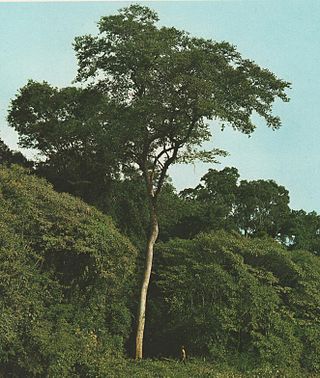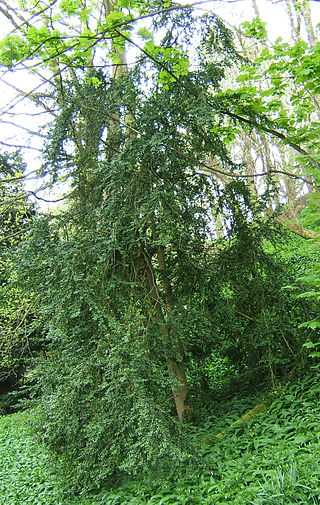
Brassicaceae or Cruciferae is a medium-sized and economically important family of flowering plants commonly known as the mustards, the crucifers, or the cabbage family. Most are herbaceous plants, while some are shrubs. The leaves are simple, lack stipules, and appear alternately on stems or in rosettes. The inflorescences are terminal and lack bracts. The flowers have four free sepals, four free alternating petals, two shorter free stamens and four longer free stamens. The fruit has seeds in rows, divided by a thin wall.

Yellow is the color between green and orange on the spectrum of light. It is evoked by light with a dominant wavelength of roughly 575–585 nm. It is a primary color in subtractive color systems, used in painting or color printing. In the RGB color model, used to create colors on television and computer screens, yellow is a secondary color made by combining red and green at equal intensity. Carotenoids give the characteristic yellow color to autumn leaves, corn, canaries, daffodils, and lemons, as well as egg yolks, buttercups, and bananas. They absorb light energy and protect plants from photo damage in some cases. Sunlight has a slight yellowish hue when the Sun is near the horizon, due to atmospheric scattering of shorter wavelengths.

Cytisus scoparius, the common broom or Scotch broom, is a deciduous leguminous shrub native to western and central Europe. In Britain and Ireland, the standard name is broom; this name is also used for other members of the Genisteae tribe, such as French broom or Spanish broom; and the term common broom is sometimes used for clarification. In other English-speaking countries, the most common name is "Scotch broom" ; however, it is known as English broom in Australia.

Maclura tinctoria, known as old fustic and dyer's mulberry, is a medium to large tree of the Neotropics, from Mexico to Argentina. It produces a yellow dye called fustic primarily known for coloring khaki fabric for U.S. military apparel during World War I. This dye contains the flavonoid morin. It is dioecious, so both male and female plants are needed to set seed.

Reseda, also known as the mignonette, is a genus of fragrant herbaceous plants native to Europe, southwest Asia and North Africa, from the Canary Islands and Iberia east to northwest India. The genus includes herbaceous annual, biennial and perennial species 40–130 cm tall. The leaves form a basal rosette at ground level, and then spirally arranged up the stem; they can be entire, toothed or pinnate, and range from 1–15 cm long. The flowers are produced in a slender spike, each flower small, white, yellow, orange, or green, with four to six petals. The fruit is a small dry capsule containing several seeds.

Luteolin is a flavone, a type of flavonoid, with a yellow crystalline appearance.

Barbarea vulgaris, also called wintercress, or alternatively winter rocket, rocketcress, yellow rocketcress, yellow rocket, wound rocket, herb barbara, creases, or creasy greens, is a biennial herb of the genus Barbarea, belonging to the family Brassicaceae.

Phellodendron amurense is a species of tree in the family Rutaceae, commonly called the Amur cork tree. It is a major source of huáng bò, one of the 50 fundamental herbs used in traditional Chinese medicine. The Ainu people used this plant, called shikerebe-ni, as a painkiller. It is known as hwangbyeok in Korean and (キハダ) kihada in Japanese.

Buxus sempervirens, the common box, European box, or boxwood, is a species of flowering plant in the genus Buxus, native to western and southern Europe, northwest Africa, and southwest Asia, from southern England south to northern Morocco, and east through the northern Mediterranean region to Turkey. Buxus colchica of western Caucasus and B. hyrcana of northern Iran and eastern Caucasus are commonly treated as synonyms of B. sempervirens.

Coptic art is the Christian art of the Byzantine-Greco-Roman Egypt and of Coptic Christian Churches. Coptic art is best known for its wall-paintings, textiles, illuminated manuscripts, and metalwork, much of which survives in monasteries and churches. The artwork is often functional, as little distinction was drawn between artistry and craftsmanship, and includes tunics and tombstones as well as portraits of saints. The Coptic Museum in Coptic Cairo houses some of the world's most important examples of Coptic art.

Berberine is a quaternary ammonium salt from the protoberberine group of benzylisoquinoline alkaloids found in such plants as Berberis vulgaris (barberry), Berberis aristata, Mahonia aquifolium, Hydrastis canadensis (goldenseal), Xanthorhiza simplicissima (yellowroot), Phellodendron amurense, Coptis chinensis, Tinospora cordifolia, Argemone mexicana, and Eschscholzia californica. Berberine is usually found in the roots, rhizomes, stems, and bark.

Reseda lutea, the yellow mignonette or wild mignonette, is a species of fragrant herbaceous flowering plant. Its leaves and flowers have been used to make a yellow dye called "weld" since the first millennium BC, although the related plant Reseda luteola was more widely used for that purpose.

Lincoln green is the colour of dyed woollen cloth formerly originating in Lincoln, England, a major cloth town during the high Middle Ages. The dyers of Lincoln, known for colouring wool with woad to give it a strong blue shade, created the eponymous Lincoln green by overdyeing this blue wool with yellow weld or dyers' broom, Genista tinctoria. Other colours like "Coventry blue" and "Kendal green" were linked to the dyers of different English towns.

Calochortus persistens is a rare North American species of flowering plant in the lily family known by the common name Siskiyou mariposa lily. It is native to northern California and southern Oregon.

Rubia tinctorum, the rose madder or common madder or dyer's madder, is a herbaceous perennial plant species belonging to the bedstraw and coffee family Rubiaceae.

Natural dyes are dyes or colorants derived from plants, invertebrates, or minerals. The majority of natural dyes are vegetable dyes from plant sources—roots, berries, bark, leaves, and wood—and other biological sources such as fungi.

Dyeing is the craft of imparting colors to textiles in loose fiber, yarn, cloth or garment form by treatment with a dye. Archaeologists have found evidence of textile dyeing with natural dyes dating back to the Neolithic period. In China, dyeing with plants, barks and insects has been traced back more than 5,000 years. Natural insect dyes such as Tyrian purple and kermes and plant-based dyes such as woad, indigo and madder were important elements of the economies of Asia and Europe until the discovery of man-made synthetic dyes in the mid-19th century. Synthetic dyes quickly superseded natural dyes for the large-scale commercial textile production enabled by the industrial revolution, but natural dyes remained in use by traditional cultures around the world.

Secondary metabolism produces a large number of specialized compounds that do not aid in the growth and development of plants but are required for the plant to survive in its environment. Secondary metabolism is connected to primary metabolism by using building blocks and biosynthetic enzymes derived from primary metabolism. Primary metabolism governs all basic physiological processes that allow a plant to grow and set seeds, by translating the genetic code into proteins, carbohydrates, and amino acids. Specialized compounds from secondary metabolism are essential for communicating with other organisms in mutualistic or antagonistic interactions. They further assist in coping with abiotic stress such as increased UV-radiation. The broad functional spectrum of specialized metabolism is still not fully understood. In any case, a good balance between products of primary and secondary metabolism is best for a plant’s optimal growth and development as well as for its effective coping with often changing environmental conditions. Well known specialized compounds include alkaloids, polyphenols including flavonoids, and terpenoids. Humans use many of these compounds for culinary, medicinal and nutraceutical purposes.

Genisteae is a tribe of trees, shrubs and herbaceous plants in the subfamily Faboideae of the family Fabaceae. It includes a number of well-known plants including broom, lupine (lupin), gorse and laburnum.

Laccaic acids or laccainic acids are a group of five anthraquinone derivatives, rated from A to E, constituting the red shellac obtained from the cochineal Kerria lacca, just like carminic acid or kermesic acid. For this article, it will mostly concentrate on the laccaic acid A (LCA).






















